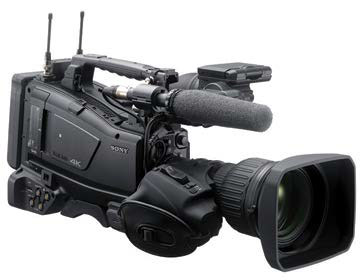2016 Product Review: Cameras
Where true 4K from 2/3-inch sensors was a stretch for most companies in 2015, this year saw some great leaps forward. And Hitachi and Ikegami showed their 8K single- sensor cameras that will be used at the upcoming Summer Olympic Games in Rio.

AJA RovoCamAJA released v1.3 firmware for the CION, AJA’s 4K/UltraHD and 2K/HD production camera. New features include improved highlight handling and black detail in every gamma mode, and new gamma naming conventions to make the modes more closely aligned to industry standards. Also new is RovoControl, a free application for controlling one or multiple AJA RovoCams. It provides efficient tools to control the complete features of AJA’s newly shipping RovoCam compact block camera for industrial, corporate, security, ProAV and broadcast.
ARRI introduced software updates for its Amira and Mini cameras, both versions 4.0. For the Amirta, Super16 lens shooting is enabled, along with a multicam mode designed for multiple cameras shooting events such as sports or concerts, or even fast-paced studio production. The update also enables 16mm lens shooting, along with anamorphic 4:3 recording along with uncompressed RAW recording. An Open Gate mode allows recording of all of a sensor’s pixels.

Blackmagic URSA Studio ViewfinderBlackmagic Design debuted a new operating system and user interface for its URSA Mini cameras. The operating system—a rewrite of its predecessor from the ground up and designed specifically for the processing architecture of the URSA Mini— allows users to quickly change settings such as ISO, white balance, shutter angle, iris, frame rate and frame guides without navigating through menus. The company also debuted the Blackmagic URSA Studio Viewfinder.
For-A showed the FT-ONE-S, an upgraded model of its FT-ONE high speed camera. It features a detachable camera head for placement in all sorts of shooting positions, and fast 500 fps shooting at 4K resolution. It utilizes a single Super 35 4096x2304 (4096x2160 DCI-compliant) sensor. Flicker correction in the HD mode has been added.
Grass Valley unveiled the LDX 86N native 4K camera series, incorporating the company’s newest UHD 2/3-inch imagers. It allows use of long zoom lenses designed for sports venues, with no unwanted cropping or zooming effects. For futureproofing, it features direct IP interface, enabling live IP remote productions. Also new from GV was the Focus 75 Live entry-level 720p/1080i switchable HD system camera.

David Woods of David Woods Productions stops to admire the Hitachi SK-UHD8060B 8K camera.Hitachi Kokusai debuted its SK-HD1300HS high-speed, slow-motion HDTV camera, designed to provide high-quality HD images at up to triple speed. The camera can simultaneously output normal- and slow-motion images, utilizing slow-motion servers from third-party partners. The company also demonstrated its SK-UHD8060 complete 8K television production system, featuring a Super 35mm CMOS sensor with 7680x4320 pixel resolution. It supports the latest HDR, wide color gamut (WCG) and high frame rate standards.
The professional video industry's #1 source for news, trends and product and tech information. Sign up below.
Ikegami unveiled its UHK-430 4K camera, designed for studio and field with B4 mount lenses. It utilizes three 2/3-inch full 4K (3840x2160) CMOS sensors with RGB prism optics. The camera is capable of 40G transmission using standard SMPTE hybrid fiber/copper camera cable. Also new was the HDL-F3000, a high sensitivity compact two-piece separate optics camera for gyro-stabilized gimbal applications.

Jose Francisco of HD Solutions in Brazil gets some practice shots with the JVC GY-HM660 camera.JVCKENWOOD presented upgraded models of its 600 Series of camcorders, including the GY-HM660, a streaming camcorder with an integrated IFB audio channel, and the GY-HM620.They feature new CMOS image sensors for greater sensitivity and a brighter LCD display for improved daylight viewing. One new capability added is the inserting of a branding logo in the camera to identify video being streamed to viewers outside of normal newscasts.
Lytro would have won the award for the most unusual camera at NAB, if there was such an award. During imaging, the Lytro Cinema camera captures every ray of light in the scene, capturing from each pixel color properties, directional properties and an exact placement in space. This provides the wherewithal later in post to focus and change depth of field, and control perspective, aperture and shutter angle.
Panasonic marked the NAB Show debut of its next-generation VariCam LT 4K cinema camcorder, a smaller, lightweight and more affordable version of its VariCam. Incorporating the identical imaging “DNA” in a more compact rendition, the VariCam LT (model AU-V35LT1G) delivers 14+ stops of dynamic range with V-Log, and cinematic VariCam image quality and color science, as well as the VariCam 35’s dual native ISOs of 800/5000. The company also announced that it is now delivering its AK-UC3000 4K system, which utilizes a single full-UHD resolution MOS sensor with an internal conversion lens that outputs a UHD signal up to 3840/2160/59.94p, while also delivering an HD image to a 2/3-inch B4 mount lens. Also in the booth was the fast, high-resolution AK-HC5000, capable of high-speed output up to 1080/239.76p. It features Flash Band Compensation that corrects for the flash band effect that can be experienced by most MOS-based imagers.
Ross Video entered the camera world with its ACID series, designed to enhance the chroma keying ability of its also-new Carbonite UltraChromeHR chroma keying system. The ACID Z50 UCHR (1080i) and ACID H200 (1080P) cameras output not only the SMPTE standard 4:2:2 video signal but an additional 0:4:4 UltrachromeHR chroma output, which is combined with the 4:2:2 signal at new keying system. The ACID cameras also work fine outside their chroma key functions.

Sony HDC-4800Sony had the only full 4K three 2/3-inch sensor camera at last year’s NAB. This year it unveiled the HDC-4800 camera system which combines 4K resolution with enhanced high frame rate capabilities, 8x at 4K, and up to 16x in full HD. Also premiering in the Sony booth was the PXWZ450 XDCAM shoulder-mount camcorder, which captures 4K (3840x2160) picture quality from a new 2/3-type Exmor R CMOS sensor, with low-light performance and networking features for fast turnaround workflows.
